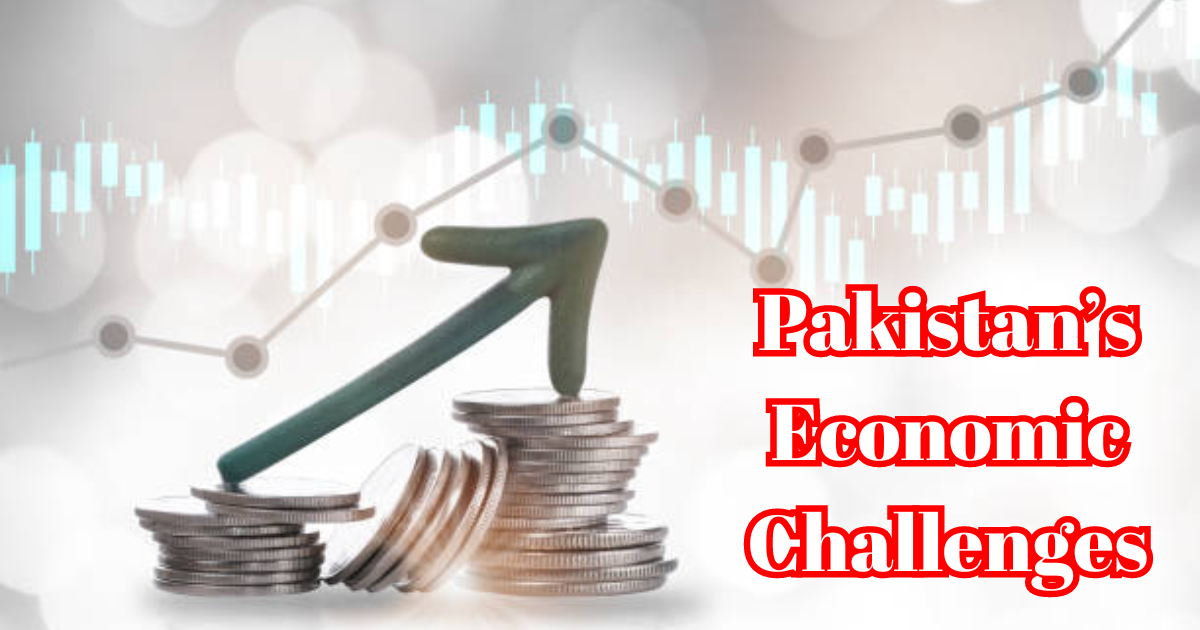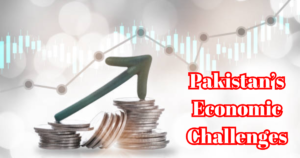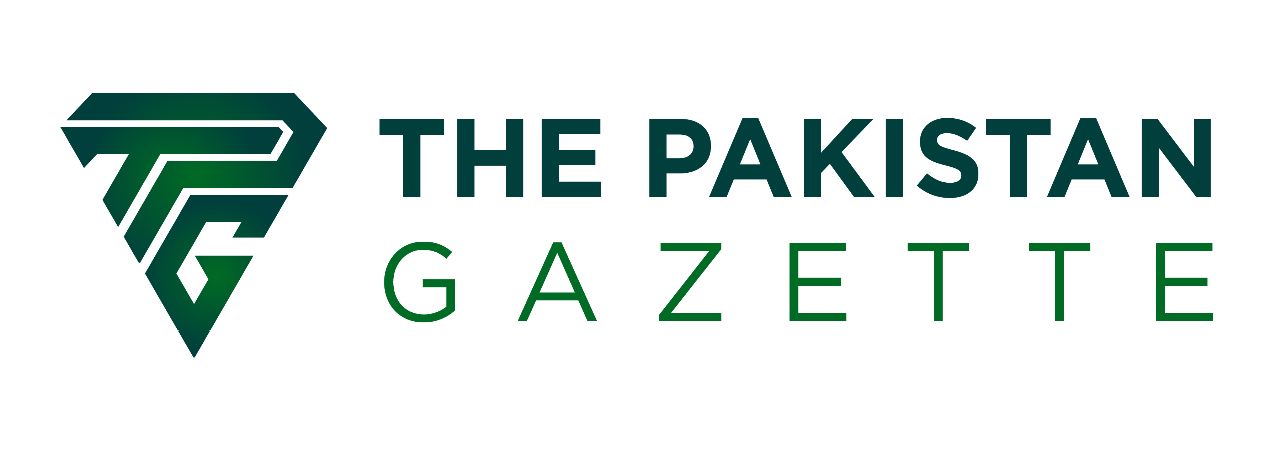
Pakistan’s Economic Challenges
An economy is a network of interconnected production and consumption processes that ultimately decide how resources are distributed among members of a society. The economy is one of the key pillars of the state; growth in the economy boosts the state’s capability and the availability of public goods. Growing economies allow states to tax that income and acquire the means and capacity to offer the public goods and services—such as healthcare, education, social security, and basic public services—that their population require.
Pakistan had thirty million citizens in 1947 and a per capita GDP of $100. Nearly half of India’s economic production came from agriculture; very little was produced elsewhere because all of the country’s industries were based there. Despite that, Pakistan was unable to feed 30 million people and was dependent on imports from the United States of America (USA). From thereon, Pakistan has come a long way.

Within the context of the area, Pakistan experienced quicker growth than South Asia for the majority of the 1960s and 1970s, averaging 2%, and comparable rates during the 1980s. Pakistan’s development, however, has lagged behind the regional average since 1993. Pakistan exported more manufactured goods in 1965 than Indonesia, Malaysia, the Philippines, Thailand, and Turkey put together, according to the World Bank (2002). Pakistan’s growth rate in the 1990s was the slowest in South Asia, a complete reverse of its prior position. Every government has come and promised to address the economic crisis, but despite their best efforts, things have not improved. The main drivers of Pakistan’s economy include the country’s current account and budgetary deficits, foreign exchange reserves, unemployment, inflation, and currency devaluation.
Pakistan, a country with a long history and a prominent position in the world, is presently battling an unparalleled economic catastrophe. The economy is on the edge of collapse due to a confluence of numerous internal and external issues. This essay examines Pakistan’s complex economic problems from a critical perspective, looking at each issue from a different angle.
Political Instability: The Bane of Economic Continuity
One of the enduring challenges plaguing Pakistan’s economy is the persistent political instability. With a history of frequent changes in government, the nation has struggled to maintain economic continuity. The oscillation in policies and decisions from one administration to another has resulted in economic disasters and ongoing instability. Since the 1970s, Pakistan has witnessed 29 prime ministers, none of whom completed a full 5-year term. This political turbulence contributes significantly to the economic woes faced by the country.
Trade Imbalances and Currency Depreciation: Struggling on the Global Stage
Pakistan’s economic landscape is marred by persistent trade imbalances and the rapid depreciation of its currency, the Pakistani Rupee (PKR). The trade deficit reached $2.8 billion in December 2022, consistently exceeding exports. To counter external trade imbalances, the country adopted a devaluation strategy, causing a significant depreciation of the PKR against the dollar. In 2022 alone, the rupee depreciated by approximately 30%, reaching its lowest point in January 2023. This has severe implications for the cost of imports, particularly in critical sectors like textiles and mobile assembly.
Soaring Inflation: The Crushing Burden on Citizens
Pakistan is grappling with soaring inflation rates, reaching a 50-year high in March 2023. The Ministry of Finance projected inflation to remain between 21% and 23% for 2023, but the actual figure surpassed expectations. In March 2023, prices rose by a staggering 35% compared to the previous year. Food inflation stood at 40%, exceeding the overall inflation rate, while transport prices surged by 41% in December 2022. The State Bank of Pakistan raised the policy rate to 20% in April 2023 to combat inflation, but its containment remains a significant challenge, adversely affecting the standard of living and diverting income away from essential needs.
Foreign Exchange Reserves Depletion: A Race Against Time
Pakistan’s foreign exchange reserves have witnessed a relentless decline, posing a severe threat to the nation’s economic stability. At the end of March 2022, reserves stood at $11.425 billion, dwindling to $6.715 billion by December 2022. Currently, Pakistan holds a meagre $3.25 billion in forex reserves, sufficient to cover only three weeks of imports. The depletion of reserves has forced the country to limit essential imports, directly impacting industries such as textiles and mobile assembly. The closure of factories and widespread job losses further exacerbate the economic challenges.
Unemployment Crisis: Industries in Peril
The economic downturn has triggered a severe unemployment crisis, particularly in key sectors like textiles. In February 2023, Pakistan’s largest petroleum refinery, Cnergyico, temporarily closed due to a lack of foreign exchange reserves and currency depreciation, making it challenging to purchase crude oil. The textile industry faces imminent collapse due to insufficient funds for essential imports, rising electricity costs, and the elimination of energy subsidies. Reports indicate that over one million people could lose their jobs in the textile sector alone. The All Pakistan Textile Mills Association (APTMA) reported the closure of 1,600 garment factories nationwide, resulting in the loss of five million jobs. Youth unemployment exceeds 31%, posing a grave socio-economic challenge.
Debt Dependency and Servicing: A Looming Threat to Fiscal Stability
Pakistan’s dependence on external debt has escalated to alarming levels, driven by factors such as corruption and income inequality. The country’s debt has increased fivefold over the past 25 years, averaging a 14% annual increase while GDP growth barely reached 3%. As of January 2023, the external debt reached 20.69 trillion PKR, with long-term loans reaching 27.51 trillion PKR. A staggering 30% of the foreign debt is owed to China. The daunting task of repaying $22 billion in 2023 adds to the unsustainable debt burden, with one-third of the budget allocated to debt servicing, surpassing the entire federal government revenue in the fiscal year 2022–23.
High-Income Inequality: A Nation Divided
Pakistan’s economic landscape is characterized by high-income inequality, with the richest 10% being 16 times wealthier than the poorest 10%. The Gini coefficient, a measure of income inequality, stands at 29.6, the worst among comparable countries. This stark wealth disparity aggravates social tensions and further deepens economic divides. The economic privileges accorded to elite groups, including the corporate sector, feudal landlords, and the military, contribute to an estimated $17.4 billion, roughly 6% of the country’s economy. Addressing this income inequality is imperative for sustainable and inclusive economic growth.
Human Capital Crisis: A Stumbling Block to Development
Beyond the fiscal and monetary challenges, Pakistan is grappling with a severe human capital crisis, which poses a substantial impediment to economic development. The country faces acute challenges in education, healthcare, and skill development. According to the World Bank, Pakistan spends only 2.8% of its GDP on education, significantly lower than the global average of 4.5%. The literacy rate, while improving, remains at 59%, with stark gender disparities. The lack of a well-educated and skilled workforce hampers innovation, productivity, and overall economic progress. Addressing the human capital deficit is crucial for fostering a knowledge-based economy and enhancing Pakistan’s global competitiveness.
Lack of Investment: Hindering Economic Growth Prospects
A critical challenge overshadowing Pakistan’s economic landscape is the persistent lack of investment, both domestic and foreign. Investment is a key driver of economic growth, but Pakistan’s investment-to-GDP ratio stands at a mere 15.5%, significantly lower than the global average. The lack of investor confidence, driven by political instability and policy uncertainties, deters both local and foreign entities from committing substantial capital to the country. This shortage of investment stifles job creation, hampers infrastructure development, and constrains the expansion of key industries. Overcoming this challenge requires comprehensive reforms to create an investor-friendly environment, ensuring stability and predictability in economic policies. The allure of Pakistan as an investment destination must be revitalized to stimulate economic growth and prosperity.
Conclusion: Navigating the Turbulent Waters Ahead
In conclusion, Pakistan’s economic challenges are multi-faceted and deeply entrenched, requiring strategic and comprehensive interventions. The intersection of political instability, trade imbalances, inflation, unemployment, forex reserves depletion, and income inequality paints a grim picture of the current economic landscape. Urgent reforms, both short-term and long-term, are imperative to stabilize the economy and pave the way for sustained growth. The international community’s support, coupled with internal policy adjustments, will be crucial in steering Pakistan away from the precipice of economic collapse. The nation stands at a critical juncture, and decisive actions must be taken to navigate the turbulent waters ahead.
Recommendations to Tackle Pakistan’s Economic Challenges
- Inflation and Trade Deficit: Macroeconomic Stability Measures: To tackle the high inflation and widening trade deficit, Pakistan must prioritize macroeconomic stability. Implementing prudent fiscal policies, including effective control of government expenditures and targeted subsidies, can help curb inflation. Simultaneously, efforts to boost exports, diversify the export basket, and negotiate favourable trade agreements can address the trade deficit.
- Energy Crisis: Investment in Renewable Energy and Efficiency Measures: Combatting the chronic energy shortages demands immediate action. Pakistan should heavily invest in diversified and sustainable energy sources, with a focus on renewable energy projects. Simultaneously, implementing energy efficiency measures across industries and promoting responsible consumption can contribute to a more stable and resilient energy sector.
- Political Instability: Comprehensive Developmental Plan: To counter the adverse effects of political instability, Pakistan needs a comprehensive developmental plan. This plan should be insulated from political interference and focus on sustainable economic growth. Engaging experts and stakeholders in drafting and implementing such a plan can ensure a long-term vision that transcends political cycles.
- Low Tax-to-GDP Ratio: Tax Reforms and Enhanced Compliance: Addressing the low tax-to-GDP ratio requires comprehensive tax reforms. Pakistan should consider broadening the tax base, removing exemptions, and ensuring progressive taxation. Additionally, enhancing tax enforcement mechanisms and leveraging technology for efficient tax collection can contribute to increased revenues.
- Current Account Deficit and External Debt: Strategic Debt Management: Efficient management of the current account deficit and external debt is imperative. Pakistan should negotiate favourable terms with creditors, explore alternative funding sources, and prioritize projects with high economic returns. Adopting a strategic debt management approach can alleviate the burden of debt servicing and contribute to overall economic stability.
- Economic Instability: Strengthening Regulatory Frameworks: Weak enforcement of policies contributes to economic instability. Strengthening regulatory frameworks and ensuring their effective implementation are critical. Additionally, measures to enhance transparency, reduce corruption, and foster a business-friendly environment can instil confidence among investors and promote sustainable economic development.
- Human Capital Flight: Education and Skill Development Initiatives: To curb the significant outflow of young talent, Pakistan should invest in education and skill development initiatives. Strengthening the education system, aligning curricula with market demands, and promoting vocational training can equip the youth with the skills needed for the job market. Creating a conducive environment for innovation and entrepreneurship can also encourage talent retention.
- Weak Enforcement of Policies: Governance and Institutional Reforms: The issue of weak policy enforcement necessitates governance and institutional reforms. Strengthening institutions, improving transparency, and depoliticizing key decision-making processes are essential. By fostering a culture of accountability and adherence to the rule of law, Pakistan can enhance policy enforcement mechanisms.
In summary, addressing Pakistan’s economic challenges requires a strategic and concerted effort. These recommendations, spanning macroeconomic stability, energy solutions, political and regulatory reforms, and investment in human capital, can collectively pave the way for a more resilient and sustainable economic future.
Pakistan’s Major Sectors of Economy
Agriculture: Struggling Growth and Vulnerability to Climate Shocks
Pakistan’s agriculture sector, once the backbone of its economy, has faced significant challenges in recent years. Between 1960 and 1990, the sector’s share dropped from 50% to 20%, reflecting a shift in the overall economic landscape. However, in recent times, agricultural growth has been sluggish, contributing to economic woes.
The catastrophic floods of 2022, as highlighted in the articles, had a devastating impact on crops, leading to food shortages and surging prices. According to a World Bank report, these floods affected 33 million people, displaced 8 million, and caused $15 billion in damage. The agricultural sector, susceptible to climate shocks, suffered from the destruction of crops, impacting both domestic consumption and export potential.
Persistent issues like outdated farming practices, water scarcity, and insufficient technology adoption further hinder agricultural productivity. As a result, the sector struggles to contribute robustly to the nation’s GDP and faces challenges in ensuring food security for its population.
Agricultural Sector: Modernization and Climate Resilience
To revive Pakistan’s agricultural sector, a multifaceted approach is required. Firstly, there is a need for the modernization of farming practices. Introducing advanced technologies, precision agriculture, and efficient water management systems can significantly enhance productivity. Investments in research and development for drought-resistant crops can mitigate the impact of climate shocks.
International collaborations, as seen in relief efforts after the 2022 floods, should extend to sustainable agricultural practices. The implementation of climate-resilient strategies, such as improved irrigation infrastructure and early warning systems, can minimize the damage caused by natural disasters.
Services: Resilience Amid Economic Turmoil
Pakistan’s services sector has shown resilience amid economic challenges, contributing significantly to the GDP. However, the service industry also faces its set of hurdles, including political instability, inflation, and an overall economic downturn.
The COVID-19 pandemic disrupted various service-oriented activities, causing a contraction in 2020. Although growth resumed in 2021, challenges like inflation and currency depreciation persisted. The services sector, encompassing areas such as finance, tourism, and telecommunications, relies heavily on economic stability. Political uncertainty and inflation can affect consumer confidence, impacting the demand for services.
Furthermore, the shortage of foreign exchange reserves, as highlighted in the articles, directly affects services like tourism and finance, as they heavily depend on stable currency values. To ensure the sustained growth of the services sector, comprehensive economic reforms and stability are imperative.
Services Sector: Economic Stability and Reforms
For the services sector to thrive, economic stability is paramount. The government should prioritize policies that ensure a stable macroeconomic environment, including measures to control inflation and manage the exchange rate. Strengthening institutions and regulatory frameworks are crucial to build investor and consumer confidence.
Additionally, targeted reforms within specific service-oriented industries, like finance and tourism, are essential. Streamlining bureaucratic processes, reducing red tape, and incentivizing innovation can foster growth. Diversifying the services portfolio beyond traditional areas can also contribute to resilience in the face of economic uncertainties.
Manufacturing: Struggling Amidst Energy Crisis and External Debt
The manufacturing sector in Pakistan, while historically contributing to economic growth, is currently grappling with significant challenges. The energy crisis, as evident in the data, poses a severe threat to industrial production. Power outages have become commonplace, impacting the operational capacity of factories and leading to temporary closures.
Moreover, the manufacturing sector faces challenges related to external debt. The reliance on loans, particularly from China, has led to a substantial burden. Debt servicing, as indicated in the articles, accounts for a considerable portion of the government’s revenues. This financial strain limits the resources available for investment in the manufacturing sector, hindering its ability to modernize and compete globally.
In addition to these macroeconomic challenges, the manufacturing sector contends with issues like outdated technology, a lack of skilled labour, and regulatory hurdles. Addressing these challenges is crucial for the sector’s revitalization, enabling it to contribute more robustly to Pakistan’s economic growth.
In conclusion, each of these sectors plays a vital role in Pakistan’s economic landscape, and addressing the challenges they face requires a comprehensive and coordinated approach encompassing policy reforms, investment, and sustainable practices.
Manufacturing Sector: Energy Solutions and Debt Management
Addressing the energy crisis is pivotal for the resurgence of Pakistan’s manufacturing sector. Investing in diversified and sustainable energy sources can mitigate power shortages. The government should prioritize the development of renewable energy infrastructure to ensure a consistent and reliable power supply for industrial units.
Efficient debt management is another critical aspect. Negotiating favourable terms with creditors and exploring alternative sources of funding can alleviate the burden of debt servicing. Concurrently, efforts to improve the ease of doing business, cut bureaucratic red tape, and provide incentives for technological upgrades can enhance the competitiveness of the manufacturing sector.
Economic Challenges of Pakistan
Admin at The Pakistan Gazette

